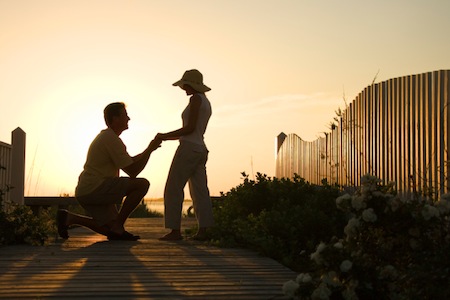Sarah Erdreich is a self-identified feminist, but she still wanted her husband to propose.
Years ago, a close friend told me that he was going to propose to his girlfriend the following week. “That’s great,” I replied, not very surprised; we’d been having this conversation for months, always followed by brainstorming ways he could do it. “So what’s the plan?” Well, he responded, they were about to go on vacation. He’d already mapped out a scavenger hunt through the city they were visiting, which would end with him proposing on a bridge, in a park. Her parents, sister, and the hotel concierge had all helped arrange the details. It would be perfect, he said.
“Wow,” I replied. “That sounds …” I fumbled for the right words. “That sounds elaborate,” I finished lamely.
“The way I see it,” my friend said, “once we’re engaged, the wedding planning will be about what she wants. This part is all mine.”
While the idea of a scavenger hunt ending with a public proposal falls just below dental surgery on my list of nightmares, my friend’s girlfriend was thrilled. Which not only goes to show that for everyone out there that loves planning multi-stage marriage proposals, there is someone that would love to receive one; it also speaks to the enduring hold that marriage proposals have on our culture. Even as marriage rates decline in this country, the expectation that eventually one half of a couple—which, in heterosexual pairings, is almost always the man—will drop to one knee and pull out a ring shows no sign of abating.
I freely admit that I’m pretty cynical when it comes to many trappings of modern weddings. Part of this is inherited—40 years ago, my parents decided to get married in such a low-key manner that it’s still a matter of debate if my father ever actually asked and my mother ever actually said yes. My mother didn’t want an engagement ring, which was lucky because my father, then a medical resident, couldn’t afford one. Instead, he gave her his med school class ring, which featured a skull and crossbones. When I was a kid, I thought this was the coolest ring ever and couldn’t understand why anyone would want diamonds. As I grew older, I began to question the entire idea of engagement rings, particularly why it was accepted that a woman should wear a visible sign that she was in a relationship while her fiancé did not. I told every one of my serious boyfriends that should they ever feel so moved to propose, to not bother with a ring. “I’d rather have a puppy,” I insisted, echoing an idea I’d read about in a magazine.
But I still found the idea of being proposed to appealing. This desire confused me, because it felt like a personal failing. I’ve identified as a feminist since I knew what the word meant, had no problem asking men out on dates, and rarely hesitated to tell boyfriends what I felt and wanted. Yet I couldn’t imagine asking the boyfriend who eventually became my husband to marry me, even though he knew I wanted to marry him and I was fairly confident that he felt the same way. My reluctance embarrassed me, and made me wonder if I was more traditional about some aspects of gender roles than I had assumed. Or was I actually being subversive, in a way? Was my preference a subconscious backlash to those declining marriage rates, a sense of “so what if this isn’t important to larger society? I care about it”? Or was something less socially conditioned and more personal at play here—was the need to be asked a reflection of deep-seated insecurities about whether my boyfriend really did feel the same way about me as I did him?
Of course, all of these wonderings just focused on how I felt. My husband, who also considers himself a feminist, had no confusion about wanting to be the one to ask me. He, and other men I know, looked at the proposal as something fun to plan, something they were allowed to be creative with in a way that men still aren’t expected to be with the actual wedding planning. But my husband was also asking in full knowledge of what my answer would be, and in this his proposal was the culmination of years of decisions that we had made together, hours of discussions that we had had about our lives. They weren’t about the proposal per se, but about the relationship on a larger scale, and they happened with a premarital depth and intimacy that my parents never would have imagined, much less their parents.
The proposal is one piece of a relationship, as distinct and separate from the day-to-day as a wedding is from a marriage. It is a concentrated expression of what the couple values and enjoys, of how they want the other to see them and how they want to tell the story of their relationship. So while our society might never fully shake the idea that one person should ask and one should answer, simply looking at that equation fails to take into account the inner workings of a relationship and the unique balance that every couple must maintain.
Sarah Erdreich is the author of Generation Roe: Inside the Future of the Pro-Choice Movement. A Southerner at heart who grew up in the Midwest, she now lives on the East Coast. Find her on Facebook and Twitter.
Related Links:

